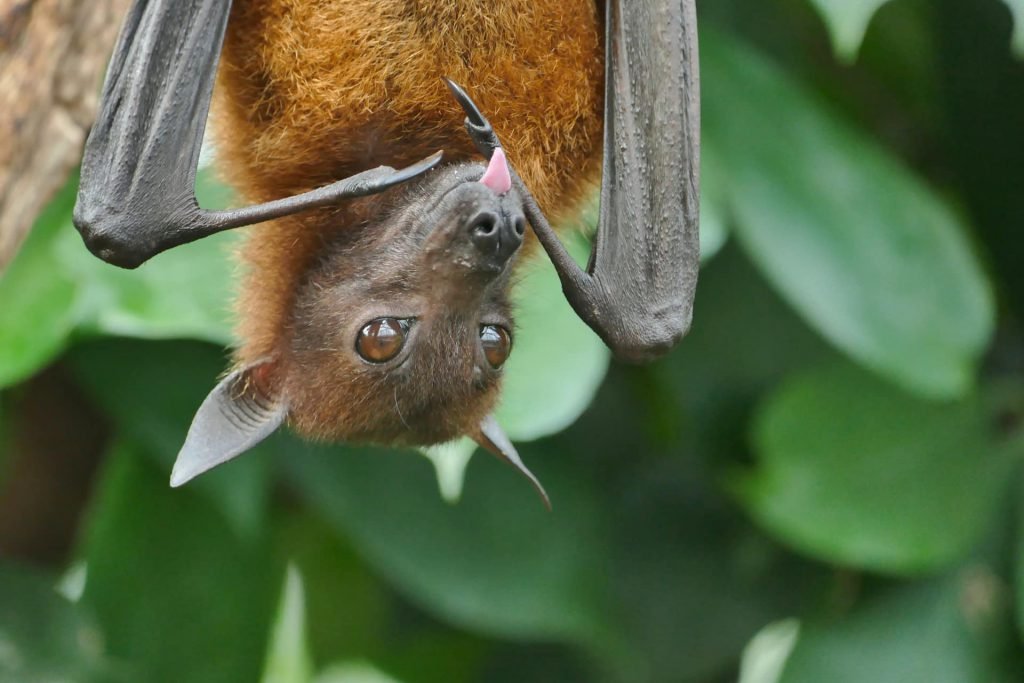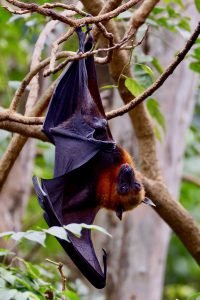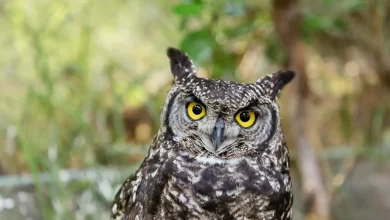Bats are mammals that can fly, and they are the only mammals capable of doing so. They’re also nocturnal, which means they only come out at night and hunt for food using echolocation. The majority of bats consume insects, but some also eat fruit and nectar, and some eat meat. Bats are generally classified into two groups. Microbats mostly use echolocation to capture insects, with only a few exceptions eating fish or drinking blood. Megabats do not use echolocation and eat fruit or nectar.
- There are over 900 to 1,200 species of bat in the world, and not one of them is blind.
- During the flight, the heartbeat of bats can reach up to 1000 beats per minute.
- The largest bat on earth is the giant golden-crowned flying fox, a rare fruit bat. It has a wingspan of 5 to 6 feet (1.5 to 1.8 m).
- The smallest mammal is the bumblebee bat of Thailand, weighing less than a penny.
- They are the only mammals in the world that can fly, and they are incredibly good at it.
- Bats are grouped into two main groups — the large fruit-eating bats (megabats) and the smaller bats (microbats) who eat insects, fish, lizards, blood, and birds. Megabats and microbats are pretty different from one another.
- Tiny woolly bats, found in West Africa, live in the large webs of colonial spiders.
- Bats can eat from one-half to three-quarters of their weight every evening.
- Most bats feed on insects, while others eat fruit, fish, or even blood!
- Vampire bats adopt orphaned bats and counts in the category of few mammals known to risk their own lives to share food.
- Bats sleep during the day and feed themselves when the sun is set.
- African heart-nosed bats can have such a keen sense of sound that they can hear the footsteps of a beetle walking on sand from six feet away.
- Frog-eating bats identify edible frogs from poisonous ones by listening to the mating call of male frogs. To counter this, Frogs hide themselves and use short calls, which makes it difficult for the bats to locate them.
- A group of bats is called a colony of bats. Some also have referred to a group of bats as a camp of bats.
- While some bats roost in groups with thousands or even millions of other bats, hoary bats and red bats like to roost alone and are found in small family groups.

- It’s not a good idea to disturb a bat who is in hibernation as the bat uses 30-60 days of stored energy to wake up out of hibernation.
- Most bats rest, sleep, mate, and give birth upside down.
- Only about 5% of all U.S. caves have the adequate temperature and water conditions suitable for bats.
- No vampire bats live in the United States except in zoos.
- The Organization for Bat Conservation (OBC) and Bat Conservation International (BCI) offer bat house kits that can be ordered online.
- A bat house at the University of Florida has a population of over 100,000 free-tailed bats.
- Bats sleep upside down so they can quickly fly away.
- Bats can eat from one-half to three quarters their weight per evening.
- Vampire bats can carry rabies, making their bites potentially dangerous.
- To see in the dark bat uses a special skill called echolocation. They make noises, and when the sound waves come, they get to know if there are any obstacles.
- Each night, vampire bats drink about half of their body weight in blood. A female vampire bat weighs about 40 grams and can consume 20 grams of blood in a 20-minute feeding. 20 grams of blood is about 20 milliliters.
- Bats are the only mammals capable of powered flights. Bats are more manoeuvrable than birds. They fly with their very long spread-out digits covered with a thin membrane or patagium.
- Bats live on every continent except Antarctica. They are found even at the Arctic Circle.
- Unlike birds, which flap their entire forelimbs, bats flap their spread-out digits.
- Bats make up about 20% of all classified mammal species globally.

- Bats sleep during the day and feed themselves when the sun is set.
- About 70% of bats eat insects. The rest 30%, are frugivores.
- Vampire bats are the only bats that can move well on the ground.
- Many bats open their mouth to call out their ultrasound echolocation signals, but others can shout through their nostrils.
- Many bats open their mouth to call out their ultrasound echolocation signals, but others can shout through their nostrils.
- The story of Dracula originated in Eastern Europe; however, real vampire bats are found only in Central and South America.
- Oilbirds are the only birds that use echolocation the way that bats do. However, bats are much better at it. A bat can even fly through the blades of a moving fan. Oilbirds are also the only nocturnal fruit-eating birds in the world.
- A small colony of bats can eat over one ton of insects in one year or more than 600 million bugs.
- There are over 1,100 bat species in the world only rodents have a more significant number of species.
- Only three species of bats constitute vampire bats.
- In West Africa, small woolly bats live in large spider webs.
- Bats spread millions of seeds every year from the ripe fruit they eat. Approximately 95% of the reforestation of the tropical rainforest is a result of seed dispersal from bats.
- Vampire bats do not actually suck blood. In reality, they lap it up like a cat. If they succeed in their hunt, they painlessly insert their sharp teeth in the artery and then let the blood trickle out into a pool before licking it.
- A vampire bat’s wingspan is typically 8 inches, though its body is about the size of an adult human thumb.
- Vampire bats body is about the size of an adult human thumb but has a wingspan of over 8 inches.

- Some white-winged vampire bats snuggle up to hens and pretend to be chicks. Once in position under the hens, the bats feed on their blood.
- More than half of all bats in the U.S. are endangered or in decline. Both habitat loss and a mysterious illness called White-Nose Syndrome (which has affected over a million bats) are among the major reasons for the decline.
- The scientific name for bats is Chiroptera, which is the Greek word for “hand wing.” The name is given because bats have four long fingers and a thumb, each connected to the next by a thin layer of skin.
- It is rare that a vampire bat bites a person, but if it does, it will then probably come back the next night to feed again from that same person.
- They use their large eyes to find food in the dark, and they tend to roost in trees rather than in caves, crevices, or old buildings. Microbats are generally much smaller and use echolocation to find insects. Microbats are typically found all over the world, including the U.S. Not all megabats are larger than microbats.
- There are several differences between megabats and microbats. The megabat has two claws, one on its thumb and one on its next finger. Microbats only have one claw on the thumb. Megabats have better-developed brains than microbats, and they also rely more on their senses (sight and smell) and less on echolocation.
- A roosting megabat will bend its neck toward its chest and look at the world upside down, while a roosting microbat will bend its neck toward its back and look at the world right-side up.
- Scientists believe that flight in bats developed before echolocation.
- A single brown bat (myotis) lives longer than most equally-sized mammals, with a life span of nearly 40 years.
- Fruit bats are a traditional food source for the people of Guam and have been hunted to the point where bats are currently listed as endangered. Guam now imports bat meat from other islands and serves as a major trade center for bat meat.
- Bat dropping is called guano and is an essential fertilizer in many tropical regions because of its high levels of phosphorus and nitrogen.
- Bats are not blind, and in fact, many bats can see quite well; some species can even detect ultraviolet light. They also have excellent echolocation, which means, contrary to urban legend, they would not get tangled in peoples hair.
- Some female bats, especially those that hibernate, can control when they give birth by storing the male’s sperm inside their body, which delays fertilization, or by slowing the development of the embryo inside them.
- In China and Japan, the bat is considered as a symbol of good luck. Two bats mean extreme happiness, and five bats represent the five blessings: tranquility, wealth, longevity, love of virtue, and natural death.
- Bats have a perfect hearing sense as they can hear frequencies between 20 Hz and 120,000 Hz, whereas humans can hear between 20 Hz and 20,000 Hz.

- In most bat colonies, all the females’ bats give birth to their babies at the same time.
- Vampire bats are the only mammals in the world that live entirely on blood.
- Most bats are brown and black, but a few are colorful shades of orange or red.
- Bats echolocation is so tuned that it can detect objects as thin as a human hair.
- For their body size, bats have larger brain than birds.
- Bat wings are made up of finger bones which are covered by thin layers of skin. The wing membranes of a bat make up about 95% of its body surface area. It is the wing membrane that helps the bat regulate their body temperature, blood pressure, water balance, and gas exchange.
- Bat-borne viruses are transmitted via bat bite and transfer via saliva, as well as aerosolization of saliva, feces, or urine. Like rabies virus, newly emerging bat-borne viruses can be transmitted to humans directly by bats. These include the Ebola virus, SARS, and the Chinese respiratory syndrome coronavirus.
- Most female bats fly with their young clinging to them, and some species have false nipples that their pups grasp during flight.
- The Bracken Bat Cave in Texas is the largest known bat colony in the world. Over 20 million bats live in the cave. When the bats leave the cave, the group is so large that it looks like a huge storm on the radar.
- Researchers were surprised to find that the female short-nosed fruit bat (Cynopterus sphinx) performs oral sex, or fellatio, on males to prolong copulation. Although fellatio has been observed in juvenile members of the chimpanzee-like bonobo, this is the first time fellatio has been seen in adult animals other than humans. Researchers argue that for bats, fellatio likely has evolutionary benefits.
- Some Mexican free-tailed bats can fly up to 250 miles (402 km) in a single night. They can fly up to 10,000 feet (3,048 m) high and reach speeds up to 60 miles per hour (97kph).
- According to Bat Conservation International, 150 big brown bats can eat enough cucumber beetles in one summer to save farmers a billion dollars a year. Those beetles would have had 33 million larvae, which are what attack the crops.
- In Southeast Asia, small club-footed bats roost inside bamboo stalks. To reach home, bats squeeze into an opening as small as 0.4 inches” about the width of a fingernail
- Wind turbines kill tens of thousands of North American bats every year. Rather than being struck by turbines, many bats appear to be killed by a sudden drop in air pressure near the spinning blades.
- Bats have few natural predators like Owl, Snakes and hawks.





